Abstract
The anomalous zonal wind moves southward during the ENSO mature phase in boreal winter. Previous studies suggest that it may be caused by the nonlinear interaction of annual cycles or the influence of background mean state changes. In this research, the ECHAM4.6 atmospheric model is used to confirm the mechanism of the anomalous zonal wind southward shifting. The annual cycle of solar radiation and SST are removed in the sensitivity experiments to avoid the interaction between the ENSO and annual cycle. The results show that the north–south asymmetry mode of the ENSO anomalous wind field is not the result of a nonlinear interaction between ENSO and the annual cycle. The mean v-winds in winter motivate the southward shifting of the ENSO anomalous wind field through advection.
1. Introduction
The El Niño-Southern Oscillation (ENSO) is the strongest air–sea coupling phenomenon in the world, exhibiting a sea surface temperature anomaly (SSTA) in the eastern equatorial Pacific [1,2,3]. During El Niño (La Niña), the positive (negative) SSTA causes anomalous westerly winds (easterly winds) and enhanced (reduced) precipitation in the tropical central Pacific [4,5]. ENSO not only impacts local weather and climate but also modulates global climate through teleconnections [6]. ENSO is considered as a significant source of predictability for global climate. It is necessary to understand its characteristics and air–sea interaction processes.
ENSO always initiates in boreal spring or summer, develops rapidly in autumn, reaches its mature phase during boreal winter, and then quickly weakens. This seasonal characteristic of ENSO is referred to as the seasonal phase-locking. During El Niño (La Niña) events, positive (negative) precipitation anomalies and low-level westerly (easterly) wind anomalies occur in the central equatorial Pacific. During the developing phase of ENSO, anomalous zonal winds are symmetric about the equator and centered on it. When ENSO reaches its mature phase during boreal winter, anomalous zonal winds are at their peak phase and located south of the equator. Subsequently, these anomalous zonal winds gradually shift northward back to the equator. The southward shifting of anomalous zonal winds may weaken thermocline response on the equator and alter charging/discharging processes, leading to the decay of ENSO [7,8].
Many studies have investigated the mechanisms of southward shifting of anomalous zonal winds in the central equatorial Pacific during the ENSO mature phase. One possible reason is seasonal variations in mean sea surface temperature (SST) [9,10,11]. Due to seasonal changes in solar radiation, the sun is directly overhead in the southern hemisphere in boreal winter, resulting in warmer SSTs being located there as part of background climate conditions. Since tropical convection can only occur above a certain temperature threshold (approximately 28 °C) [12,13], enhanced convective activity is more likely to happen when warm SSTA overlay warmer mean state south of the equator [14]. Therefore, convective anomalies and associated wind anomalies are more pronounced over the southern hemisphere. McGregor et al. proposed that as the South Pacific Convergence Zone (SPCZ) is strengthened during winter, the mean wind speed is decreased. It alters the Ekman coefficient and reduces friction, resulting in enhanced anomalous meridional winds south of the equator [15]. Stuecker et al. argued that ENSO and the annual cycle of climatological background fields interact through nonlinear processes to generate combination mode (C-mode), with asymmetric patterns in anomalous zonal wind during winter [16,17].
Previous study conducted a quantitative budget on anomalous zonal wind during ENSO, suggesting that the meridional advection by climatological mean winds plays a crucial role in driving the southward shifting of anomalous zonal winds during the ENSO mature phase [18,19]. As the position of direct sunlight shifts meridionally with seasons, mean precipitation and wind patterns undergo seasonal changes. In boreal winter, when the direct sunlight reaches its southernmost point, higher sea surface temperatures in the southern hemisphere favor enhanced precipitation development. Consequently, there is a strong band of mean precipitation over the South Pacific (which is SPCZ) in boreal winter, accompanied by cross-equatorial northerly winds that are distinct from the other three seasons. When ENSO occurs, the SSTA triggers anomalous zonal wind in the equatorial central Pacific. The cross-equatorial northerly winds transport larger anomalous winds southward, facilitating development of anomalous wind fields south of the equator. Meridional advection by mean winds plays a crucial role in causing southward shift of ENSO-related anomalous wind fields.
In previous studies, some researchers believed that the north–south asymmetry of anomalous wind fields is a result of the interaction between ENSO and nonlinear annual cycles [16,17], while others suggested it is caused by changes in the mean state due to annual cycles [9,10,11,18]. Although both viewpoints agree that this meridional distribution of wind fields is related to annual cycles, the mechanisms are different in their physical explanations. Therefore, further research is needed to confirm the underlying mechanisms. This study employs numerical simulations to artificially remove the influence of ENSO and investigate the impact mechanism of annual cycles on ENSO’s anomalous wind fields. The remainder of the paper is organized as follows. Section 2 describes the data, model and methods. Section 3 presents the observational evolution of anomalous zonal wind during ENSO. The experiments are carried out to examine the mechanisms of anomalous zonal wind in Section 4. Finally, a conclusion is given in Section 5.
2. Data, Model and Method
The observed data used in this study include monthly sea surface temperature (SST) data from the Hadley Centre Sea Ice and SST dataset (referred to as HadISST1.1) by the UK Met Office’s Hadley Centre [20], as well as daily three-dimensional wind field and precipitation data from the European Centre for Medium-Range Weather Forecasts’ ERA-5 reanalysis dataset [21]. The time range covers January 1980 to December 2023. To eliminate the influence of global warming, all data are detrended.
To investigate the influence of annual cycles on ENSO anomalous wind fields, this study conducted numerical experiments using the atmospheric circulation model ECHAM4.6 developed by the Max Planck Institute for Meteorology in Germany [22]. The ECHAM atmospheric circulation model originated from the weather forecast spectral model of the European Centre for Medium-Range Weather Forecasts (ECMWF). The ECHAM series of atmospheric circulation models have been widely used in climate change research, and several coupled models with this component were applied in IPCC climate change numerical experiments, demonstrating excellent performance. This model is based on the original atmospheric dynamic equations, with a resolution of 42 wave triangular stages (T42) and a latitude–longitude resolution of 2.8° × 2.8°. In the vertical direction, it has 19 layers using σ-p hybrid coordinates (from surface to 10 hPa). Detailed information about the experimental design scheme is shown in Section 4 of this article.
To understand the mechanism for the anomalous zonal wind equatorial asymmetry, we diagnose the anti-symmetric zonal momentum budget following Gong and Li (2021) [18]. Firstly, each variable is decomposed into a symmetric and an anti-symmetric component relative to the equator. Variables can be decomposed into [23]
where y denotes latitude, and subscripts s and a represent the symmetric and anti-symmetric components, respectively.
The anti-symmetric zonal momentum budget equation can be written as follows:
where u, v, ω denote the 3-dimensional (3D) wind, denotes the zonal wind tendency, , , and are 3D advection terms, is the Coriolis parameter, φ denotes the geopotential height, and denotes the apparent momentum sink term that is calculated using daily raw data and the original zonal momentum equation following Yanai et al. (1973) [24]. A prime denotes the interannual anomaly, and subscript a represents the anti-symmetric component of each term.
3. The Time Evolution of Anomalous Zonal Wind during ENSO
We select ENSO cases based on the sea surface temperature anomaly (SSTA) averaged over 5° S–5° N, 170° W–120° W (Nino3.4 region) in D(0)JF(1) (Figure 1). The anomaly is calculated based on the climatological mean in the period 1980–2023. The El Niño cases are selected when the Nino3.4 index exceeds 0.5 positive standard deviation as follows: 1982/1983, 1986/1987/1988, 1991/1992, 1994/1995, 1997/1998, 2002/2003, 2004/2005, 2006/2007, 2009/2010, 2015/2016, 2018/2019. The La Niña cases are selected when Nino3.4 is less than one negative standard deviation as following: 1983/1984/1985, 1988/1989, 1995/1996, 1998/1999/2000, 2005/2006, 2007/2008/2009, 2010/2011/2012, 2016/2017, 2020/2021/2022. The composite low-level anomalous zonal wind and SSTA are shown in Figure 2. The SSTA locates on the eastern Pacific with the strongest in boreal winter. The anomalous zonal wind in the central Pacific firstly shows a semi-symmetric pattern in autumn, but moves southward obviously (Figure 3). The maximum of the southward extension could be 5° S for both El Niño and La Niña.

Figure 1.
SSTA averaged over 5° S–5° N, 170° W–120° W (Nino3.4 region) in D(0)JF(1).
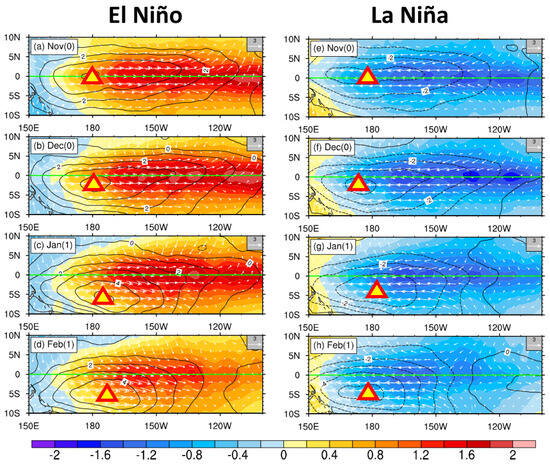
Figure 2.
Composite SSTA (shading, K), anomalous surface wind (vector, m/s) and anomalous zonal wind averaged over 1000–700 hPa (contour, m/s) in Nov(0)–Feb(1) for (a–d) El Niño and (e–h) La Niña. The triangles mark the maximum (minimum) of anomalous zonal wind for El Niño (La Niña).
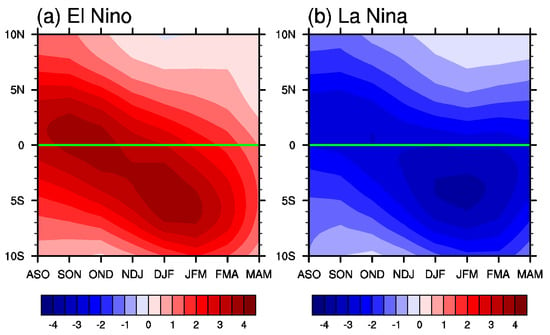
Figure 3.
Time evolution of 1000–700 hPa anomalous zonal wind (m/s) averaged over 160° E–160° W for composite (a) El Niño and (b) La Niña.
Gong and Li [18] conducted an anti-symmetric zonal momentum budget for composite ENSO cases and pointed out that the fundamental term is the meridional advection of anomalous zonal wind by the mean v-wind. The seasonal cycle (Figure 4) shows that the central Pacific shows low-level cross-equatorial northerly wind in boreal winter, with the SPCZ reaching its mature phase. The mean cross-equatorial northerly transports anomalous zonal wind from the equator to the south. It determines the southward shifting of anomalous wind in the central Pacific during ENSO.
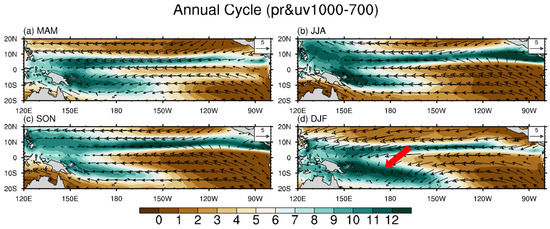
Figure 4.
The seasonal cycle of mean precipitation (shading, mm/day) and mean wind averaged over 1000–700 hPa (vector, m/s). The climatological mean period is 1980–2023. The red arrow in (d) represents the cross-equatorial northerly in boreal winter.
The mechanism proposed by Gong and Li [18] pointed out the importance of the annual cycle in the background. Some previous studies [16,17,25] have also suggested that the annual cycle influences the spatial patterns of anomalous wind during ENSO, but they attribute this asymmetric mode to the nonlinear interaction between annual cycles and the ENSO cycle. Is the meridional shift of anomalous zonal wind of ENSO related with meridional advection by the annual cycle or the nonlinear interaction with the annual cycle? In the following, we will design sensitivity experiments to explore the mechanism.
4. The Sensitivity Experiments of Anomalous Zonal Wind Modulated by Mean State
Since ENSO always matures in boreal winter in observations, numerical models can be employed to verify the modulating effect of annual cycles on ENSO wind anomalies. The experiments designed by Li et al. [26] only considered the impact of the mean SST annual cycle while neglecting solar radiation. Solar radiation serves as the basis for the annual cycle of various physical quantities. Based on this, we designed two sets of experiments, each consisting of a control run and a sensitivity run. In the control run, the mean state remains unchanged, while in the sensitivity run, an El Niño-like warm SSTA is added (Figure 5). To ensure that the experimental results are not influenced by asymmetric sea surface temperature anomalies, symmetric SSTAs are added in the sensitivity runs. The specific experimental designs are shown in Table 1. There is no annual cycle in each experiment.
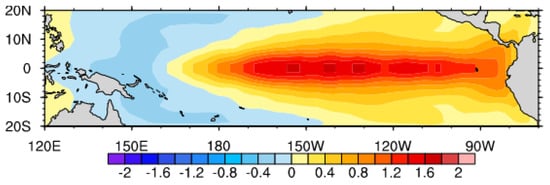
Figure 5.
A symmetric El Niño-like SSTA added to the sensitivity runs (unit: K).

Table 1.
Two sets of experimental designs of control run and sensitivity run.
The ECHAM4.6 is an only-atmosphere model forced by the SST. The control run is forced by the unchangeable climatological SST in boreal winter (summer) all year in Set 1 (Set 2). The sensitivity run is forced by the climatological SST in winter (summer) plus El Niño-SSTA in the equatorial Pacific (see the pattern in Figure 5) all year in Set 1 (Set 2). The difference between the sensitivity run and the control run is the atmospheric response of El Niño-SSTA in different background mean states. In the first set of experiments, solar radiation is fixed on the Tropic of Capricorn, and background SST is maintained at boreal winter state. Therefore, in this set of experiments, the background mean state remains in boreal winter. In contrast, in the second set of experiments, solar radiation was fixed on the Tropic of Cancer, and background SSTs are maintained at boreal summer state. Both sets of experiments excluded any periodic variations in climate backgrounds or ENSO cycles, in order to observe changes in atmospheric responses to ENSO under different background conditions. Each experiment is integrated for 20 years, and only the last 10 years are analyzed as atmospheric responses to sea surface temperature anomalies. The atmospheric model is the global model, but we only focus on the results in the equatorial Pacific.
In the first set, the annual cycle of the mean state is removed, with the mean SST and solar radiation remaining constant during boreal winter. In this setting, the subsolar point locates on the South Tropic of Capricorn all the time, with a warm SST center located in the southern hemisphere. Under this configuration, the seasonal cycles of precipitation and wind are almost eliminated (Figure 6). The SPCZ remains changeless all year, while the equatorial central Pacific consistently exhibits cross-equatorial southward winds. The ACwin_SSTA sensitivity experiment adds a warm SSTA in the tropical Pacific, and the result is shown in Figure 7. El Niño-like warm SSTA triggers anomalous westerly winds and positive precipitation anomalies over the equatorial central Pacific. The atmospheric response shows spatial asymmetry characteristics with maximum westerly wind anomalies located south of the equator around 4° S–5° S. In this set of experiments, both the background annual cycle and ENSO cycle do not exist, since El Niño-like warm SSTAs persist throughout all year. Therefore, ENSO cycles and annual cycles do not interact with each other. Despite their absence, anomalous wind southward migration still occurs in the sensitivity run. This indicates that asymmetric winter wind anomalies associated with ENSO events are primarily influenced by cross-equatorial southward winds of the mean state rather than by interactions between the ENSO cycle and annual cycle.
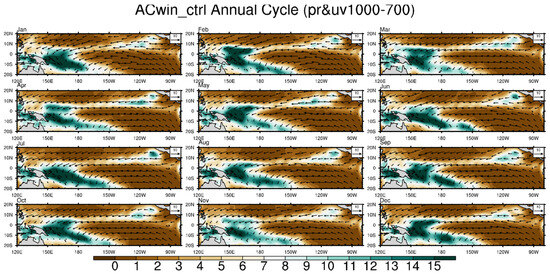
Figure 6.
The annual cycle of mean precipitation (shading, mm/day) and mean 1000 hPa wind (vector, m/s) in ACwin_ctrl.
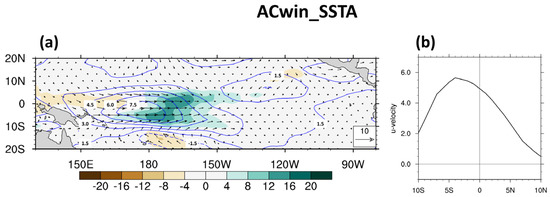
Figure 7.
The atmospheric response in boreal winter (DJF) in ACwin_SST: (a) anomalous wind (vector, m/s), anomalous zonal wind (contour, m/s) and anomalous precipitation (shading, mm/day). (b) The anomalous zonal wind averaged over 160° E–170° W.
We then conduct the same anti-symmetric zonal momentum budget as Gong and Li (2021) [18] for ACwin_SSTA (Figure 8). The budget result shows the major contributor is the meridional advection, which is related with the cross-equatorial mean northerly in boreal winter. The pressure gradient force also plays an important role. The asymmetric pressure gradient force is attributed to the asymmetric precipitation response. The mean SST is warmer in the southern hemisphere during boreal winter, and the superimposed warm SSTA is more likely to trigger precipitation anomalies. Further, the larger anomalous zonal wind could advect larger amounts of moisture from the western Pacific in the southern hemisphere, inducing a stronger precipitation response and wind response in this situation [18].
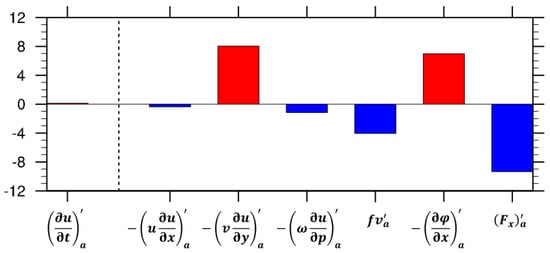
Figure 8.
The anti-symmetric zonal momentum budget terms averaged over 15° S–15° N, 160° E–170° W for ACwin_SSTA. Units: m s−1 mon−1.
To compare with the first set of experiments, we designed a second set of experiments where background states keep the mean SST and solar radiation constant in boreal summer. In this setting, the solar radiation is directly over the Northern Tropics during all seasons, so the warmest SST locates in the northern hemisphere. Under this background condition, the SPCZ disappears with only one mean precipitation belt in the northern hemisphere, while cross-equatorial northward winds prevail over the central Pacific along the equator (Figure 9). In the sensitivity experiment, ACsum_SSTA, El Niño-like SSTA is added all year. There is still no annual cycle or ENSO cycle in this experiment and therefore no interaction between them. In ACsum_SSTA (results shown in Figure 10), anomalous precipitation response to ENSO mainly existed north of the equator with corresponding wind anomalies centered in the northern hemisphere around 2° N–4° N. In the absence of an annual cycle, cross-equatorial southward winds as part of background conditions led to a northward shift in anomalous winds associated with ENSO.
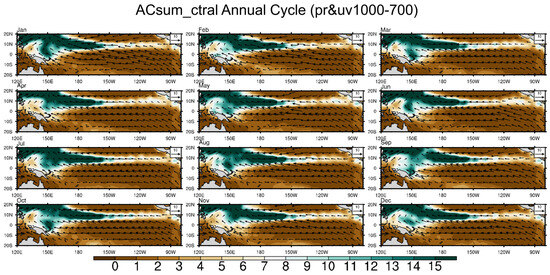
Figure 9.
The annual cycle of mean precipitation (shading, mm/day) and mean 1000 hPa wind (vector, m/s) in ACsum_ctrl.
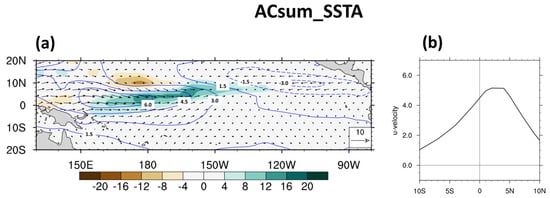
Figure 10.
The atmospheric response in boreal winter (DJF) in ACsum_SST: (a) anomalous wind (vector, m/s), anomalous zonal wind (contour, m/s) and anomalous precipitation (shading, mm/day). (b) The anomalous zonal wind averaged over 150° E–170° W.
Li et al. [26] also used the only-atmosphere model to conduct the sensitivity experiments to examine the mechanism of equatorially asymmetric atmospheric response during ENSO. In their sensitivity experiments, which refer to no annual cycle, they set the remaining SST pattern in September, and the results do not show obviously southward shifting. Thus, they conclude that the southward shifting is the result of interaction of the annual cycle and ENSO cycle. However, in our two sets of experiments, neither the annual cycle nor ENSO cycle exist. The results show southward shifting (in winter mean state) and northward shifting (in summer mean state), indicating the importance of the background mean state. It was found that the meridional movement of anomalous winds during ENSO does not require interaction between ENSO and the annual cycle; it can be achieved solely by altering the background field. Sensitivity experiments conducted using atmospheric circulation models indicate that the nonlinear interaction between the annual cycle and ENSO is not the main cause for the southward shift of anomalous winds. Instead, it is primarily driven by a winter mean state resulting from seasonal variations in solar radiation.
5. Conclusions
ENSO events exhibit strong seasonality in their development. ENSO always initiates and develops during spring and summer, reaches maturity in winter, and then rapidly decays. Throughout the life cycle of ENSO, SSTAs consistently display quasi-symmetric patterns around the equator, while anomalous winds tend to be asymmetric with a southward shift during winter. Previous studies have suggested that this asymmetry of the anomalous wind field may be influenced by annual cycles, potentially resulting from nonlinear interactions between ENSO and the annual cycle or modulation by mean cross-equatorial wind. In this study, we utilized the ECHAM4.6 atmospheric model to investigate how the annual cycle affects spatial patterns of anomalous winds associated with ENSO. Sensitivity experiments were conducted by disabling variations in solar radiation and sea surface temperatures, thereby only altering background conditions without any annual cycle or ENSO cycle. The results demonstrate that the background mean state in winter can induce southward-shifting of anomalous winds associated with ENSO, whereas the mean state in summer can induce northward-shifting of anomalous winds. Therefore, our experiment results confirm that the asymmetric anomalous wind fields related to ENSO in boreal winter are modulated by the mean state. Due to direct sunlight over the southern hemisphere during boreal winter, when SPCZ intensity is at its peak, cross-equatorial mean winds in the equatorial Pacific lead to a southward shift in anomalous westerlies via meridional advection. This study contributes to a deeper understanding of ENSO dynamics by revealing the significant modulating effect of the background mean state on the ENSO wind fields. This provides a valuable reference for numerical simulations and predictions of ENSO.
Author Contributions
Conceptualization, Y.G.; methodology, Y.G. and J.L.; software, T.L.; validation, J.L.; data curation, Y.G.; writing—original draft, Y.G. All authors have read and agreed to the published version of the manuscript.
Funding
This research was supported by Jiangsu Natural Science Key Project (23KJB170004), the project of KLME and CIC-FEMD (KLME202304), Suzhou Meteorological Bureau Scientific Research Project (SZKJ202303), the project of Jinan meteorological bureau (2024jnqxzd01).
Institutional Review Board Statement
Not applicable.
Informed Consent Statement
Not applicable.
Data Availability Statement
Publicly available datasets were analyzed in this study. The HadISST data can be obtained from https://www.metoffice.gov.uk/hadobs/hadisst/data/download.html (accessed on 4 May 2024). The ERA-5 can be obtained from https://cds.climate.copernicus.eu/cdsapp#!/dataset/reanalysis-era5-pressure-levels-monthly-means?tab=overview (accessed on 20 June 2024).
Conflicts of Interest
The authors declare no conflicts of interest.
References
- Philander, S.G. El Niño, La Niña, and the Southern Oscillation; International geophysics series; Academic Press: Cambridge, MA, USA, 1990; Volume 46, 293p. [Google Scholar]
- Rasmusson, E.M.; Carpenter, T.H. Variations in tropical sea surface temperature and surface wind fields associated with the Southern Oscillation/El Niño. Mon. Weather Rev. 1982, 110, 354–384. [Google Scholar] [CrossRef]
- Cane, M.A.; Zebiak, S.E. A theory for El Niño and the Southern Oscillation. Science 1985, 228, 1085–1087. [Google Scholar] [CrossRef] [PubMed]
- Cane, M.A. A role for the tropical Pacific. Science 1998, 282, 59–61. [Google Scholar] [CrossRef]
- Deser, C.; Wallace, J.M. El Niño events and their relation to the Southern Oscillation: 1925–1986. J. Geophys. Res. Oceans 1987, 92, 14189–14196. [Google Scholar] [CrossRef]
- Wallace, J.; Rasmusson, E.; Mitchell, T.; Kousky, V.; Sarachik, E.; Von Storch, H. On the structure and evolution of ENSO-related climate variability in the tropical Pacific: Lessons from TOGA. J. Geophys. Res. Oceans 1998, 103, 14241–14259. [Google Scholar] [CrossRef]
- McGregor, S.; Ramesh, N.; Spence, P.; England, M.H.; McPhaden, M.J.; Santoso, A. Meridional movement of wind anomalies during ENSO events and their role in event termination. Geophys. Res. Lett. 2013, 40, 749–754. [Google Scholar] [CrossRef]
- Abellán, E.; McGregor, S. The role of the southward wind shift in both, the seasonal synchronization and duration of ENSO events. Clim. Dyn. 2016, 47, 509–527. [Google Scholar] [CrossRef]
- Vecchi, G.A. The Termination of the 1997–98 El Niño. Part II: Mechanisms of Atmospheric Change. J. Clim. 2006, 19, 2647–2664. [Google Scholar] [CrossRef]
- Spencer, H. Role of the atmosphere in seasonal phase locking of El Niño. Geophys. Res. Lett. 2004, 31, 1–5. [Google Scholar] [CrossRef]
- Lengaigne, M.; Boulanger, J.-P.; Menkes, C.; Spencer, H. Influence of the Seasonal Cycle on the Termination of El Niño Events in a Coupled General Circulation Model. J. Clim. 2006, 19, 1850–1868. [Google Scholar] [CrossRef]
- Graham, N.; Barnett, T. Sea surface temperature, surface wind divergence, and convection over tropical oceans. Science 1987, 238, 657–659. [Google Scholar] [CrossRef] [PubMed]
- Gadgil, S.; Joseph, P.; Joshi, N. Ocean–atmosphere coupling over monsoon regions. Nature 1984, 312, 141–143. [Google Scholar] [CrossRef]
- Takahashi, K.; Dewitte, B. Strong and moderate nonlinear El Niño regimes. Clim. Dyn. 2016, 46, 1627–1645. [Google Scholar] [CrossRef]
- McGregor, S.; Timmermann, A.; Schneider, N.; Stuecker, M.F.; England, M.H. The Effect of the South Pacific Convergence Zone on the Termination of El Niño Events and the Meridional Asymmetry of ENSO. J. Clim. 2012, 25, 5566–5586. [Google Scholar] [CrossRef]
- Stuecker, M.F.; Timmermann, A.; Jin, F.-F.; McGregor, S.; Ren, H.-L. A combination mode of the annual cycle and the El Niño/Southern Oscillation. Nat. Geosci. 2013, 6, 540–544. [Google Scholar] [CrossRef]
- Stuecker, M.F.; Jin, F.-F.; Timmermann, A.; McGregor, S. Combination Mode Dynamics of the Anomalous Northwest Pacific Anticyclone. J. Clim. 2015, 28, 1093–1111. [Google Scholar] [CrossRef]
- Gong, Y.; Li, T. Mechanism for Southward Shift of Zonal Wind Anomalies during the Mature Phase of ENSO. J. Clim. 2021, 34, 8897–8911. [Google Scholar] [CrossRef]
- Gong, Y.; Li, T. Comparison of southward shift mechanisms of equatorial westerly anomalies between EP and CP El Niño. Clim. Dyn. 2023, 60, 785–796. [Google Scholar] [CrossRef]
- Rayner, N.A.; Parker, D.E.; Horton, E.B.; Folland, C.K.; Alexander, L.V.; Rowell, D.P.; Kent, E.C.; Kaplan, A. Global analyses of sea surface temperature, sea ice, and night marine air temperature since the late nineteenth century. J. Geophys. Res. Atmos. 2003, 108, 4407. [Google Scholar] [CrossRef]
- Hersbach, H.; Bell, B.; Berrisford, P.; Dahlgren, P.; Horányi, A.; Munoz-Sebater, J.; Nicolas, J.; Radu, R.; Schepers, D.; Simmons, A. The ERA5 Global Reanalysis: Achieving a detailed record of the climate and weather for the past 70 years. Eur. Geophys. Union Gen. Assem. 2020, 146, 1999–2049. [Google Scholar]
- Roeckner, E.; Arpe, K.; Bengtsson, L.; Christoph, M.; Claussen, M.; Dümenil, L.; Esch, M.; Giorgetta, M.A.; Schlese, U.; Schulzweida, U. The Atmospheric General Circulation Model ECHAM-4: Model Description and Simulation of Present-Day Climate; Max-Planck-Institut fuer Meteorologie: Hamburg, Germany, 1996. [Google Scholar]
- Li, T. Air–sea interactions of relevance to the ITCZ: Analysis of coupled instabilities and experiments in a hybrid coupled GCM. J. Atmos. Sci. 1997, 54, 134–147. [Google Scholar] [CrossRef]
- Yanai, M.; Esbensen, S.; Chu, J.-H. Determination of bulk properties of tropical cloud clusters from large-scale heat and moisture budgets. J. Atmos. Sci. 1973, 30, 611–627. [Google Scholar] [CrossRef]
- Zhang, W.; Li, H.; Jin, F.-F.; Stuecker, M.F.; Turner, A.G.; Klingaman, N.P. The Annual-Cycle Modulation of Meridional Asymmetry in ENSO’s Atmospheric Response and Its Dependence on ENSO Zonal Structure. J. Clim. 2015, 28, 5795–5812. [Google Scholar] [CrossRef]
- Li, H.; Zhang, W.; He, J.; Wang, Y. Influence of SST annual cycle on local air-sea processes during El Niño events. Haiyang Xuebao 2016, 38, 56–68. [Google Scholar] [CrossRef]
Disclaimer/Publisher’s Note: The statements, opinions and data contained in all publications are solely those of the individual author(s) and contributor(s) and not of MDPI and/or the editor(s). MDPI and/or the editor(s) disclaim responsibility for any injury to people or property resulting from any ideas, methods, instructions or products referred to in the content. |
© 2024 by the authors. Licensee MDPI, Basel, Switzerland. This article is an open access article distributed under the terms and conditions of the Creative Commons Attribution (CC BY) license (https://creativecommons.org/licenses/by/4.0/).